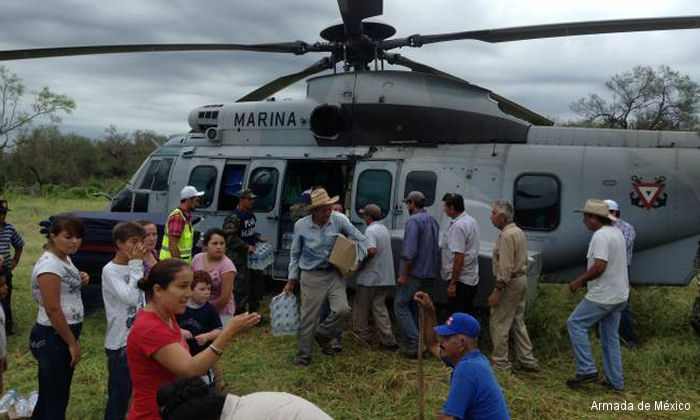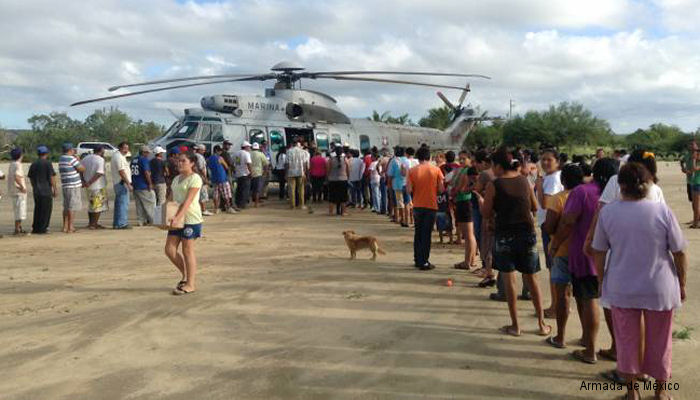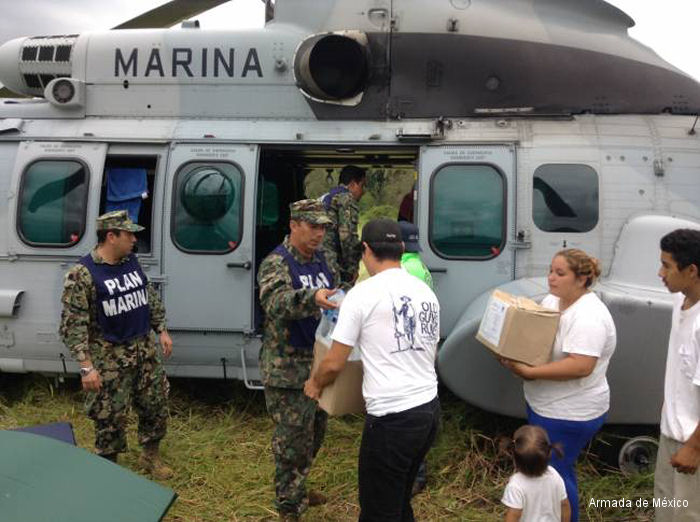Airbus Helicopters, November 17, 2014 - by Beata Cece - When it came, the storm blew at speeds of over 200 kilometers per hour. In mid-September 2014, Hurricane Odile hit the Mexican peninsula state of Baja California, destroying 95 percent of the electricity network in some regions and cutting off the water supply for large parts of the population.
Only two days after the hurricane had left its trail of destruction, two Mexican Navy EC725s arrived in the area to perform transport and rescue missions.
Two of the helicopter pilots flying this mission, Roberto Antonio Castillejos Ricardez and Arturo Zavala Herrera, talk about their work after the catastrophe that battered hotels, stranded travelers and leveled entire neighborhoods in villages such as Las Casitas, El Ranchito, San Vicente, Cape Pulomó, San Felipe and Boca Mermaid.
What did you see when you arrived in Baja California?
We arrived in La Paz, the capital city of Baja California, only two days after the hurricane had hit the area and the conditions were disastrous. There was no light, the two electrical power lines which feed the area had fallen and the airport was destroyed. We saw long lines of people, tourists and locals, waiting for a flight to be evacuated by plane.
And we remember a lot of families with children, looking worried, tired and desperate. Some of them had lost everything in the storm.
What was your mission?
There was a high risk of looting in commercial centers and private homes, so we conducted surveillance flights day and night to try and keep this to a minimum. We worked in coordination with the Federal Preventive Police and the Mexican Air Force.
We also performed evacuations and delivered groceries and boxes provided by the Red Cross and other humanitarian organizations containing water, bedding, food and basic necessities for the people affected. The helicopter can carry up to three tons of food, which is about 500 pantries, one per family.
Initially we flew an average of four hours a day for surveillance operations, and went up to six hours of flight a day when we started delivering goods.
Which features of the EC725 were most important to you on this mission?
We really took advantage of the machine’s configuration. When we distributed goods we used the speakers and sirens to warn residents.
We used the winch when it was impossible to land and the searchlight for night flights. The SPECTRO LAB searchlight, with an intensity of 20,000 candelas, was very useful, especially because of the lack of electricity.
The DMAP (digital maps) allowed us to carry out monitoring functions more accurately because of its topographic maps at a scale of 1:50,000, which allowed us to identify the names of the villages more accurately.
And the avionics of the EC725 like the autopilot, the flight management system and the digital maps really helped, especially at night when flying over water. For example, we flew three and a half hours uninterrupted from Mazatlan to Los Cabos in Baja California over the sea.
How did people react when you arrived?
People expressed their gratitude, because they were desperately waiting for help, although some felt they had been waiting too long.
Ultimately, everyone gave their best to support us. People gave us enough space to land by lining up in rows and the police helped distributing the goods.
What were the keys to your success?
The configuration and avionics of the Cougar EC725 allowed to tackle everything during this mission. They provided great versatility for a variety of operations, ranging from flights carrying personnel and supplies to surveillance flights, both during the day and at night.
This meant we could directly help the population and contribute to the various government institutions that were providing support at the time.
An excellent crew and good organization on the ground were also key, as well as the knowledge and experience we had gained from previous similar operations.
Only two days after the hurricane had left its trail of destruction, two Mexican Navy EC725s arrived in the area to perform transport and rescue missions.
Two of the helicopter pilots flying this mission, Roberto Antonio Castillejos Ricardez and Arturo Zavala Herrera, talk about their work after the catastrophe that battered hotels, stranded travelers and leveled entire neighborhoods in villages such as Las Casitas, El Ranchito, San Vicente, Cape Pulomó, San Felipe and Boca Mermaid.
We arrived in La Paz, the capital city of Baja California, only two days after the hurricane had hit the area and the conditions were disastrous. There was no light, the two electrical power lines which feed the area had fallen and the airport was destroyed. We saw long lines of people, tourists and locals, waiting for a flight to be evacuated by plane.
And we remember a lot of families with children, looking worried, tired and desperate. Some of them had lost everything in the storm.
There was a high risk of looting in commercial centers and private homes, so we conducted surveillance flights day and night to try and keep this to a minimum. We worked in coordination with the Federal Preventive Police and the Mexican Air Force.
We also performed evacuations and delivered groceries and boxes provided by the Red Cross and other humanitarian organizations containing water, bedding, food and basic necessities for the people affected. The helicopter can carry up to three tons of food, which is about 500 pantries, one per family.
Initially we flew an average of four hours a day for surveillance operations, and went up to six hours of flight a day when we started delivering goods.
We really took advantage of the machine’s configuration. When we distributed goods we used the speakers and sirens to warn residents.
We used the winch when it was impossible to land and the searchlight for night flights. The SPECTRO LAB searchlight, with an intensity of 20,000 candelas, was very useful, especially because of the lack of electricity.
The DMAP (digital maps) allowed us to carry out monitoring functions more accurately because of its topographic maps at a scale of 1:50,000, which allowed us to identify the names of the villages more accurately.
And the avionics of the EC725 like the autopilot, the flight management system and the digital maps really helped, especially at night when flying over water. For example, we flew three and a half hours uninterrupted from Mazatlan to Los Cabos in Baja California over the sea.
People expressed their gratitude, because they were desperately waiting for help, although some felt they had been waiting too long.
Ultimately, everyone gave their best to support us. People gave us enough space to land by lining up in rows and the police helped distributing the goods.
The configuration and avionics of the Cougar EC725 allowed to tackle everything during this mission. They provided great versatility for a variety of operations, ranging from flights carrying personnel and supplies to surveillance flights, both during the day and at night.
This meant we could directly help the population and contribute to the various government institutions that were providing support at the time.
An excellent crew and good organization on the ground were also key, as well as the knowledge and experience we had gained from previous similar operations.
See also |
EC725 Caracal in







